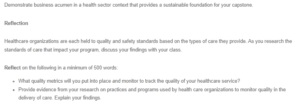Leading the Organization through Change
Quality Metrics to be put in Place to Monitor and Track the Quality of My Health Care Service
The service that my healthcare organization provides is a management and education program for heart disease using a mobile app and a wearable bracelet for measuring heart-related parameters. Employing quality metrics to monitor and track the quality of this program is essential to ensure it meets its goals, adheres to the set regulations and standards, and supports continuous quality improvement. The quality metrics to be put in place to monitor and track the quality of the health care service include patient satisfaction, cost-effectiveness of the program, and effectiveness of the program.
The patient satisfaction quality metric will focus on the self-reported user experiences with the app and the bracelet. It will also focus on how engaged the patients are with the program. Patient experiences will be collected using surveys, requests to leave feedback, and a rating for their experiences with the app and bracelet. Engagement will be measured based on the overall usage of the app and the user’s use of the app to connect with medical experts.
The cost-effectiveness of the program quality will focus both on the affordability of the app and bracelet as well as the ability of the programs to make returns on the initial investment. Affordability will further be based on how many people purchase the bracelets, download the app, and purchase certain services using the app. On the other hand, return on investment will be measured by comparing the costs of care for a single patient before and after the implementation of the service. The cost-effectiveness also considers data security and privacy and reported related issues.
The effectiveness of the program as a quality metric will be based on the assessment of the population’s health knowledge related to heart disease before and after implementation, notable lifestyle changes among users, ability to self-care, and adherence to the program and its provisions. It will also consider how easy it is to access the health information.
Monitoring Quality in the Delivery of Care
The quality employed to monitor and track the quality of my health care service is in line with the practices and programs used by health care organizations to monitor quality in the delivery of care and are well backed by sufficient evidence. For instance, patient satisfaction and experiences with care are mostly used as metrics of quality in healthcare. Patient satisfaction is a multifaceted construct that appraises the patient’s experience with the care provided in a healthcare facility (Satpathy et al., 2022). The satisfaction level results from the experiences with the care provided. Patient experience and patient satisfaction with the care provided are valid quality metrics as they both are based on self-reported reflection on whether or not the provided care has met the needs and expectations of the patient (Larson et al., 2019).
The cost-effectiveness of care is also a measure of the quality of healthcare services delivered. Quality of care is arguably the ability of health services provided to individuals or communities to improve and achieve desirable health outcomes. Quality care is effective, safe, and person-centered (Larson et al., 2019). This means minimized risk of harm, longer lengths of stay, and reduced risks of comorbidity and mortality. This translates to a reduced need for care services and less healthcare expenditure.
Another quality metric in healthcare settings is outcome measures. These include measures related to mortality rates, reinfection rates, and other factors of a health condition or situation. Clinical outcomes such as lowered disease rates, low number of new cases, and lifestyle changes are outcome measures that can be used to benchmark quality of care (Ruseckaite et al., 2019). Other evidence-based practices and programs for measuring quality in healthcare include process measures, indicators of patient safety, and regulatory compliance. Top of Form
References
Larson, E., Sharma, J., Bohren, M. A., & Tunçalp, Ö. (2019). When the patient is the expert: measuring patient experience and satisfaction with care. Bulletin of the World Health Organization, 97(8), 563. https://doi.org/10.2471/BLT.18.225201
Ruseckaite, R., Maharaj, A. D., Krysinska, K., Dean, J., & Ahern, S. (2019). Developing a Preliminary Conceptual Framework for Guidelines on Inclusion of Patient Reported-Outcome Measures (PROMs) in Clinical Quality Registries</p>. Patient Related Outcome Measures, Volume 10, 355–372. https://doi.org/10.2147/PROM.S229569
Satpathy, S., Wundaville, L. T., Satapathy, S., Malik, A., Singh, S., Singh, A. R., Chadda, R., Barre, V. P., & Tiwari, S. K. (2022). A Systematic Review of Patient Satisfaction Scales and Their Applicability to Covid-19 Hospitalized Patients: Gaps and Emerging Needs. Journal of Patient Experience, 9. https://doi.org/10.1177/23743735221079132
ORDER A PLAGIARISM-FREE PAPER HERE
We’ll write everything from scratch
Question 

Leading the Organization through Change
Demonstrate business acumen in a health sector context that provides a sustainable foundation for your capstone.
Reflection
Healthcare organizations are each held to quality and safety standards based on the types of care they provide. As you research the standards of care that impact your program, discuss your findings with your class.
Reflect on the following in a minimum of 500 words:
- What quality metrics will you put into place and monitor to track the quality of your healthcare service?
- Provide evidence from your research on practices and programs used by health care organizations to monitor quality in the delivery of care. Explain your findings.